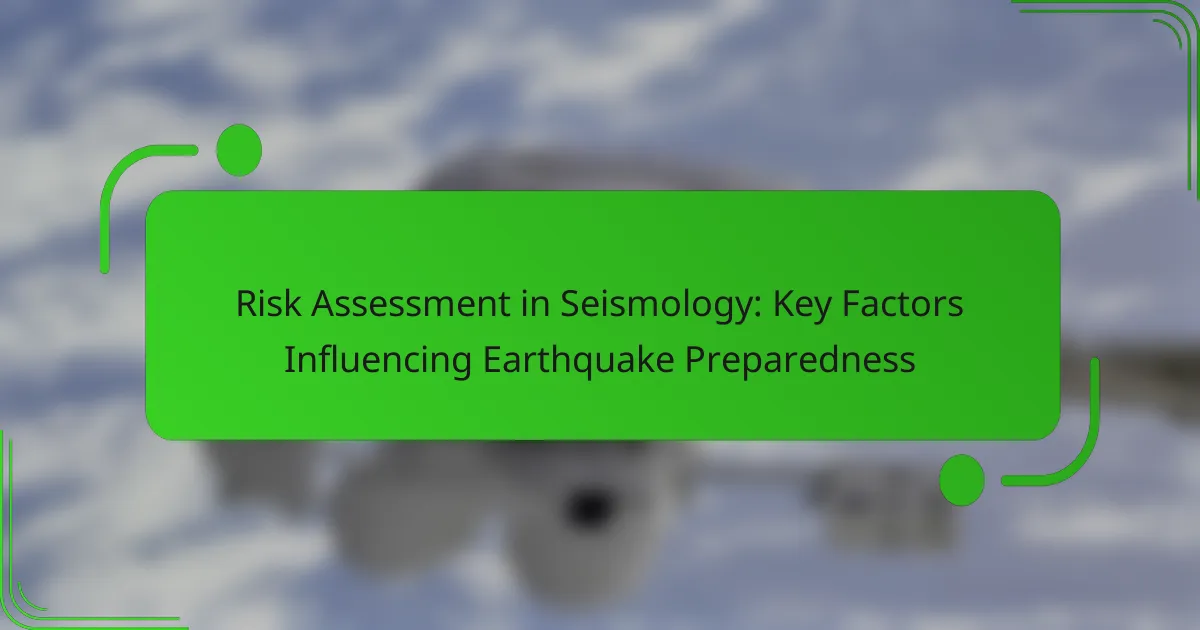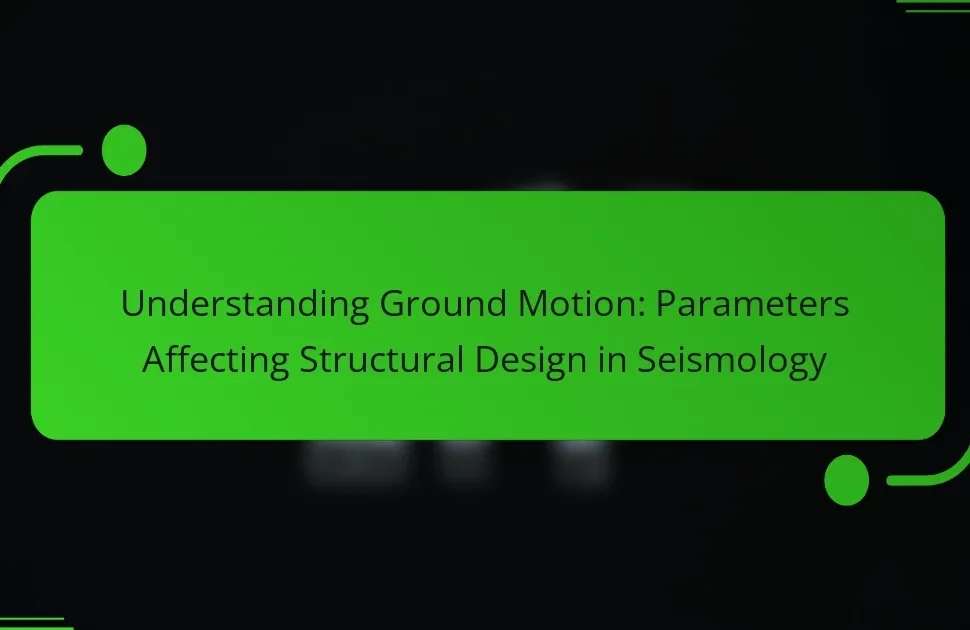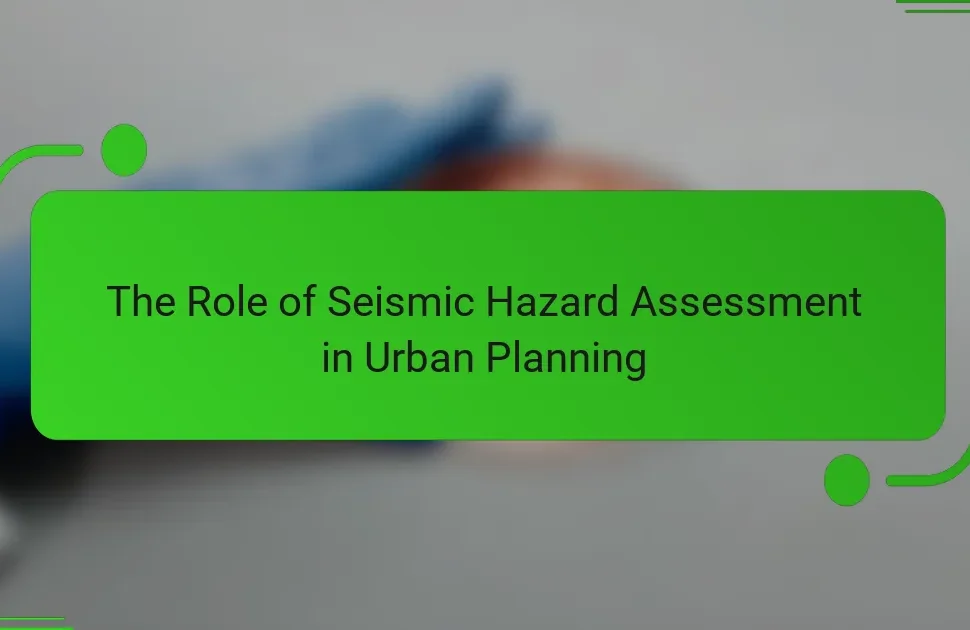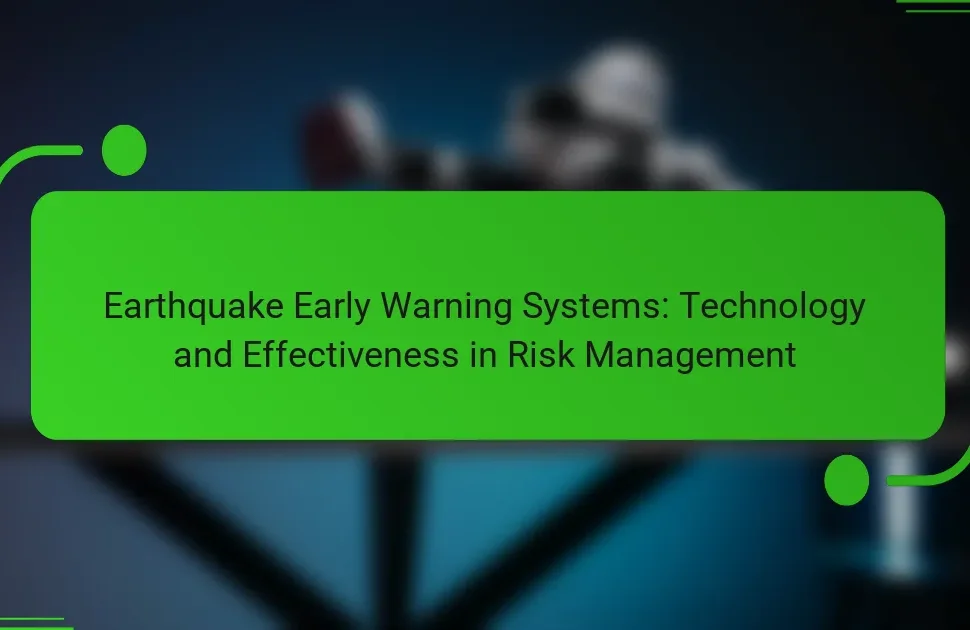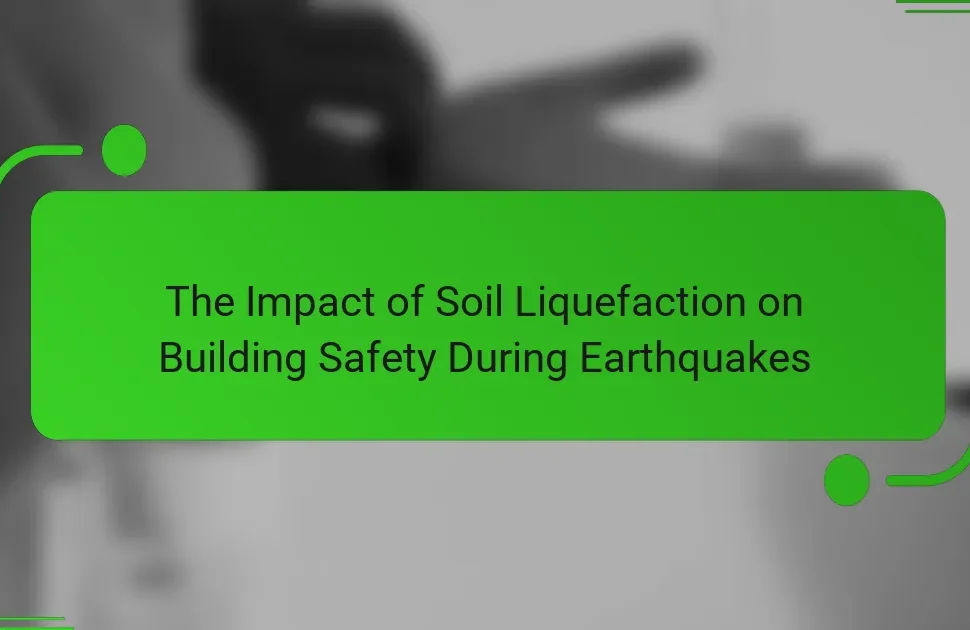Risk assessment in seismology evaluates the potential impacts of earthquakes on communities and infrastructure. This process involves analyzing seismic hazards, vulnerabilities, and exposures, utilizing methodologies such as probabilistic seismic hazard assessment (PSHA) and deterministic seismic hazard assessment (DSHA). Key factors influencing this assessment include geological conditions, historical data, building codes, and community preparedness initiatives. Accurate risk assessments are essential for informing emergency response strategies, urban planning, and reducing earthquake-related damages and fatalities. Understanding these elements is crucial for enhancing community resilience against seismic events.
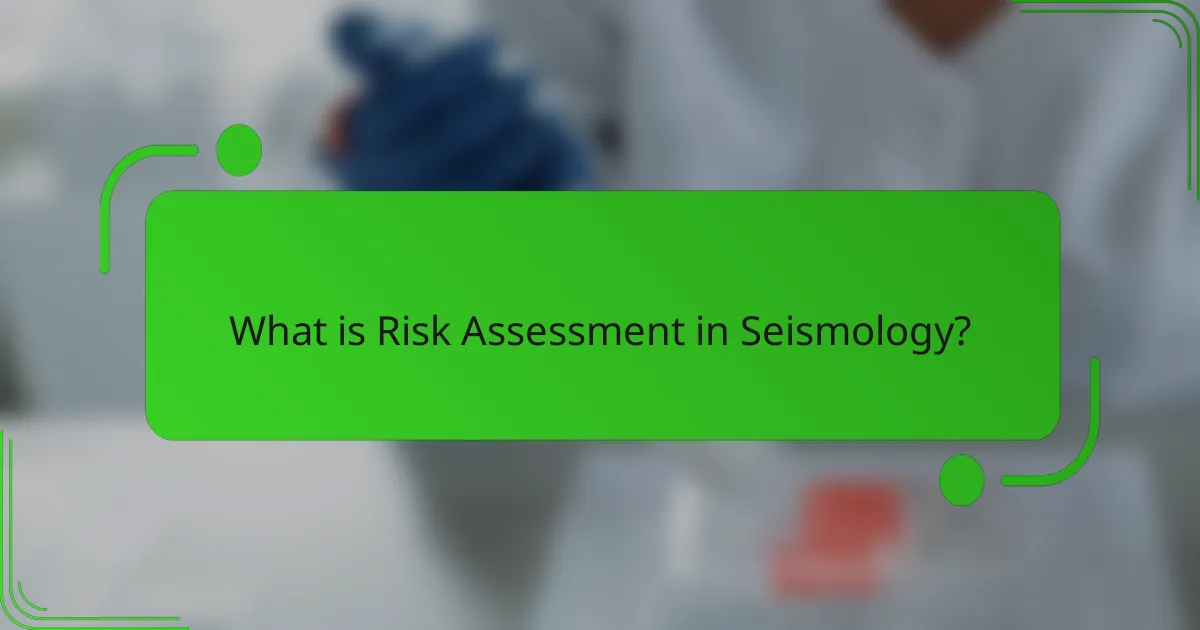
What is Risk Assessment in Seismology?
Risk assessment in seismology is the process of evaluating the potential impacts of earthquakes on communities and infrastructure. This assessment involves analyzing historical seismic data, geological characteristics, and building vulnerabilities. It aims to identify areas at high risk for seismic activity. Quantitative methods, such as probabilistic seismic hazard assessments, are often used. These methods estimate the likelihood of different earthquake scenarios occurring over time. Risk assessment helps inform emergency preparedness and response strategies. It is crucial for developing building codes and land-use planning. Accurate risk assessments can significantly reduce earthquake-related damages and fatalities.
How is risk assessment defined in the context of seismology?
Risk assessment in seismology is the process of evaluating the potential impact of earthquakes on communities and infrastructure. It involves identifying hazards, assessing vulnerabilities, and estimating the likelihood of seismic events. This assessment helps in understanding the risks associated with earthquakes. It also guides preparedness and mitigation strategies. Studies indicate that effective risk assessment can significantly reduce earthquake-related damages. For instance, the U.S. Geological Survey emphasizes the importance of seismic hazard assessments in urban planning. These assessments provide critical data for emergency response and resource allocation.
What are the key components of risk assessment in seismology?
The key components of risk assessment in seismology include hazard identification, vulnerability assessment, and risk analysis. Hazard identification involves determining the likelihood and potential impact of earthquakes in a specific area. Vulnerability assessment evaluates the susceptibility of structures and populations to earthquake damage. Risk analysis combines the hazard and vulnerability data to estimate potential losses and impacts. These components are essential for effective earthquake preparedness and mitigation strategies. Accurate risk assessments guide planning and resource allocation for disaster response.
How does risk assessment differ from risk management in seismology?
Risk assessment in seismology identifies and evaluates potential earthquake hazards and vulnerabilities. It involves analyzing seismic data, historical events, and geological conditions to estimate the likelihood and impact of earthquakes. In contrast, risk management in seismology focuses on implementing strategies to mitigate identified risks. This includes developing emergency response plans, enforcing building codes, and educating communities about earthquake preparedness. The distinction lies in risk assessment being analytical, while risk management is action-oriented. For example, the United States Geological Survey (USGS) conducts risk assessments to inform risk management decisions in earthquake-prone areas.
Why is risk assessment crucial for earthquake preparedness?
Risk assessment is crucial for earthquake preparedness because it identifies potential hazards and vulnerabilities. By understanding the likelihood and impact of earthquakes, communities can develop effective response strategies. Risk assessment helps prioritize resources for mitigation efforts. It informs building codes and land-use planning to enhance safety. Historical data shows that regions with thorough risk assessments experience lower casualties. For instance, California’s seismic safety measures have significantly reduced damage during earthquakes. Overall, risk assessment is essential for minimizing risks and enhancing resilience against seismic events.
What role does risk assessment play in mitigating earthquake impacts?
Risk assessment plays a crucial role in mitigating earthquake impacts by identifying and evaluating potential hazards. It helps communities understand the likelihood and severity of earthquakes in their area. Through this evaluation, risk assessment informs the development of preparedness strategies. These strategies can include building codes, emergency response plans, and public education initiatives. For instance, the Federal Emergency Management Agency (FEMA) emphasizes the importance of risk assessment in their guidelines for earthquake preparedness. Historical data shows that regions with comprehensive risk assessments experience fewer casualties and property damage during earthquakes. Therefore, effective risk assessment directly contributes to enhanced safety and resilience against seismic events.
How can effective risk assessment enhance community resilience?
Effective risk assessment enhances community resilience by identifying vulnerabilities and prioritizing resources. It helps communities understand potential hazards and their impacts. By evaluating risks, communities can develop targeted preparedness plans. These plans facilitate timely responses during emergencies. Effective risk assessment also fosters collaboration among stakeholders. It encourages community engagement in resilience-building activities. Research indicates that communities with robust risk assessments recover faster after disasters. For example, the National Institute of Building Sciences reports that every dollar invested in mitigation saves six dollars in future disaster costs.
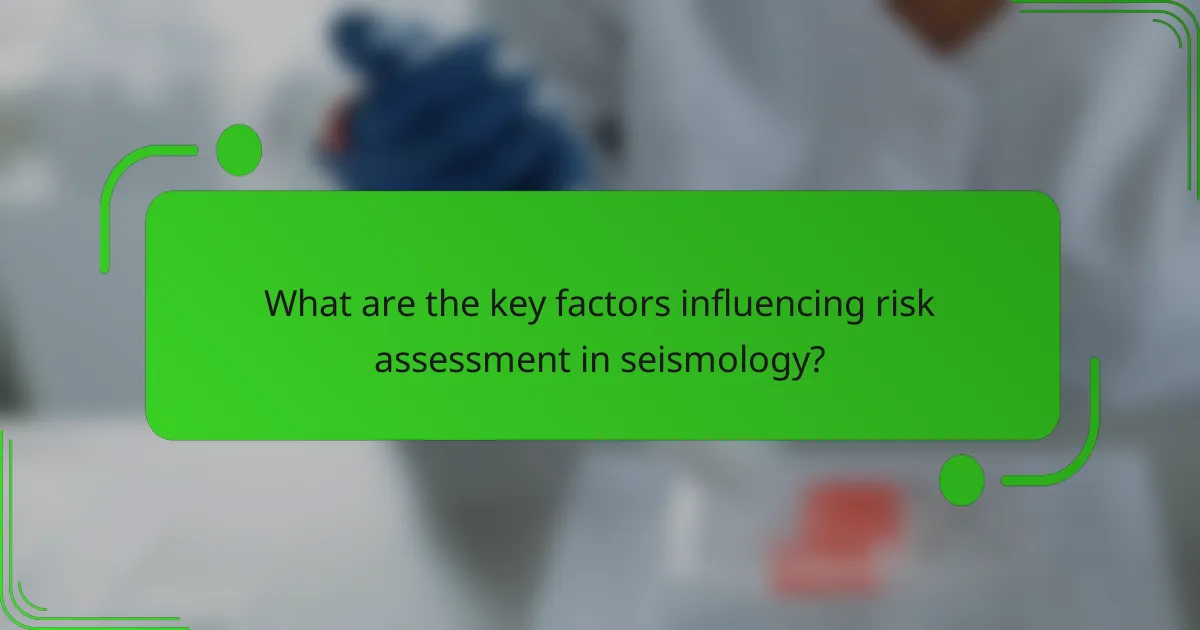
What are the key factors influencing risk assessment in seismology?
Key factors influencing risk assessment in seismology include seismic hazard, vulnerability, and exposure. Seismic hazard refers to the likelihood of earthquakes occurring in a specific area. Vulnerability assesses the potential damage to structures and populations during an earthquake. Exposure involves the number of people and assets at risk in a given region.
Geological conditions also impact risk assessment. Areas with soft soil or near fault lines are more susceptible to severe shaking. Historical earthquake data provides insights into patterns and potential future events.
Building codes and land use planning affect vulnerability and exposure. Regions with strict regulations tend to have lower damage rates. Public education and preparedness initiatives influence community resilience.
These factors collectively shape the understanding of earthquake risk and guide mitigation strategies.
How do geological factors affect earthquake risk assessment?
Geological factors significantly influence earthquake risk assessment. These factors include tectonic plate boundaries, fault lines, and soil composition. Tectonic plate boundaries are regions where plates interact, often resulting in seismic activity. Fault lines are fractures in the Earth’s crust where movement occurs, indicating potential earthquake zones. Soil composition affects ground shaking and building stability during an earthquake. For example, loose, unconsolidated soils can amplify seismic waves, increasing damage risk. Historical data shows that areas near active faults experience higher earthquake frequencies. Therefore, understanding these geological factors is crucial for accurate risk assessment and preparedness strategies.
What types of geological data are essential for accurate assessments?
Essential geological data for accurate assessments include seismic data, soil composition, and fault line mapping. Seismic data provides information about past and current earthquake activity. Soil composition affects ground stability and amplification of seismic waves. Fault line mapping identifies potential earthquake sources. Additionally, geological age and history inform risk levels. These data types are crucial for understanding seismic hazards and preparing for earthquakes. Accurate assessments rely on comprehensive geological information to mitigate risks effectively.
How do fault lines and seismic history influence risk evaluations?
Fault lines and seismic history significantly influence risk evaluations. Fault lines indicate locations where tectonic plates interact, often resulting in earthquakes. Evaluations consider the proximity of structures to these fault lines. Historical seismic activity provides data on the frequency and magnitude of past earthquakes. This information helps assess potential risks for future events. Areas with a history of significant seismic activity are rated higher in risk evaluations. For instance, California’s San Andreas Fault has a documented history of major earthquakes. This historical context informs building codes and disaster preparedness plans. Overall, fault lines and seismic history are critical in determining earthquake risk levels.
What role do building codes and regulations play in risk assessment?
Building codes and regulations are essential in risk assessment for earthquake preparedness. They establish minimum safety standards for construction. These standards help ensure that buildings can withstand seismic forces. Compliance with building codes reduces the likelihood of structural failure during earthquakes. Studies show that regions with stringent codes experience fewer casualties and property damage. For example, California’s building codes have significantly improved resilience to seismic events. This proactive approach minimizes risks to life and property. Therefore, building codes and regulations play a critical role in enhancing overall safety during earthquakes.
How do local building codes impact earthquake preparedness?
Local building codes significantly impact earthquake preparedness by establishing standards for construction and retrofitting. These codes dictate the materials, design, and structural integrity required for buildings in earthquake-prone areas. Compliance with these regulations reduces the risk of structural failure during seismic events. For example, buildings constructed under stringent codes are often designed to withstand specific levels of ground shaking. Research indicates that regions with updated building codes experience fewer casualties and less property damage in earthquakes. The Federal Emergency Management Agency (FEMA) emphasizes that adherence to local building codes is crucial for minimizing risks associated with seismic activity.
What are the challenges in enforcing building regulations for seismic safety?
Enforcing building regulations for seismic safety faces several challenges. One major challenge is the lack of uniformity in regulations across different jurisdictions. This inconsistency can lead to confusion and non-compliance. Additionally, limited resources for inspection and enforcement hinder effective regulation. Many local governments lack the funding and manpower needed to ensure compliance with seismic codes.
Another challenge is the resistance from builders and developers. They may prioritize cost-cutting over compliance with safety standards. This can result in inadequate construction practices that do not meet seismic safety requirements.
Public awareness and education also play a crucial role. Many property owners are unaware of seismic risks and the importance of compliance. This lack of knowledge can lead to negligence in adhering to regulations.
Finally, the evolving nature of seismic science presents a challenge. As new research emerges, regulations must be updated to reflect the latest findings. This can create a lag in enforcement as codes are revised and implemented.

What methodologies are used in seismological risk assessment?
Seismological risk assessment employs several methodologies. These methodologies include probabilistic seismic hazard assessment (PSHA) and deterministic seismic hazard assessment (DSHA). PSHA evaluates the likelihood of seismic events and their potential impacts over time. It incorporates historical seismic data, geological studies, and fault models. DSHA focuses on specific earthquake scenarios and their expected ground shaking. This approach uses known fault characteristics and maximum expected magnitudes. Another methodology is the seismic risk assessment, which combines hazard estimates with vulnerability analysis. This assesses the potential damage to structures and infrastructure. These methodologies are vital for informing urban planning and disaster preparedness strategies.
What are the primary methods for assessing earthquake risk?
The primary methods for assessing earthquake risk include seismic hazard assessment, building vulnerability assessment, and risk modeling. Seismic hazard assessment evaluates the likelihood of various earthquake magnitudes occurring in a specific area. This involves analyzing historical seismic data and geological conditions. Building vulnerability assessment examines the structural integrity of buildings and infrastructure against potential earthquakes. This includes identifying weaknesses in design and materials. Risk modeling combines hazard and vulnerability data to estimate potential impacts, including economic losses and human casualties. These methods are essential for effective earthquake preparedness and mitigation strategies.
How do probabilistic seismic hazard assessments work?
Probabilistic seismic hazard assessments (PSHAs) estimate the likelihood of seismic events and their potential impacts. PSHAs integrate geological, seismological, and engineering data to model earthquake probabilities. They use historical earthquake records to identify patterns and frequencies. The assessments calculate ground shaking and other effects at specific locations. This involves defining seismic sources, such as fault lines. The models account for uncertainties in both the seismic sources and the ground response. PSHAs produce hazard curves that show the probability of exceeding different ground shaking levels over a given time period. These assessments are crucial for informing building codes and public safety measures.
What is the significance of deterministic seismic hazard assessments?
Deterministic seismic hazard assessments are crucial for understanding potential earthquake impacts. They provide specific estimates of ground shaking and related effects for defined locations. This helps in designing buildings and infrastructure to withstand seismic forces. The assessments use historical data and geological models to predict scenarios. They inform emergency preparedness and response strategies. Accurate assessments reduce risks to life and property. Studies show that regions with such assessments have lower damage during earthquakes. Overall, they enhance community resilience against seismic events.
How is technology transforming risk assessment in seismology?
Technology is transforming risk assessment in seismology by enhancing data collection and analysis. Advanced seismic sensors provide real-time data on ground movements. This allows for quicker and more accurate assessments of earthquake risks. Geographic Information Systems (GIS) integrate seismic data with geographical data. This helps in visualizing and analyzing risk areas more effectively. Machine learning algorithms analyze large datasets to predict seismic events. These predictions improve preparedness and response strategies. Remote sensing technologies offer insights into fault lines and geological structures. This information helps in assessing potential earthquake impacts on communities. Overall, technology significantly enhances the precision and reliability of seismic risk assessments.
What role do GIS and remote sensing play in modern assessments?
GIS and remote sensing are essential tools in modern assessments, particularly in seismology. They enable the collection, analysis, and visualization of spatial data related to earthquakes. GIS integrates various data sources, allowing for comprehensive mapping of seismic hazards. Remote sensing provides real-time data on land use and geological features. This data helps in identifying vulnerable areas and assessing potential risks. Studies have shown that GIS can improve the accuracy of risk assessments by up to 30%. Remote sensing also aids in monitoring post-earthquake damage and recovery efforts. Together, they enhance decision-making processes for earthquake preparedness and response strategies.
How can data analytics improve the accuracy of risk predictions?
Data analytics enhances the accuracy of risk predictions by leveraging large datasets to identify patterns and trends. It processes historical earthquake data, geological surveys, and real-time sensor information. Advanced algorithms analyze these data points to predict potential seismic events. Machine learning models improve over time as they learn from new data. This leads to more precise risk assessments and timely alerts. Studies show that data-driven predictions can increase forecast accuracy by up to 30%. For example, the US Geological Survey utilizes data analytics to refine earthquake probability models, improving public safety measures.
What best practices should be followed for effective risk assessment?
Effective risk assessment involves a systematic approach to identifying and analyzing potential hazards. This includes gathering relevant data on seismic activity and historical earthquake patterns. Engaging with local communities enhances the understanding of specific risks they face. Utilizing advanced modeling techniques allows for accurate predictions of potential impacts. Regularly updating risk assessments ensures they remain relevant as conditions change. Collaboration with experts in seismology improves the quality of the assessment. Training personnel in risk assessment methodologies fosters a knowledgeable workforce. Documenting findings and sharing results promotes transparency and encourages preparedness.
How can communities implement effective risk assessment strategies?
Communities can implement effective risk assessment strategies by conducting thorough hazard evaluations. This involves identifying potential seismic risks in the area. Communities should utilize historical data on past earthquakes to inform their assessments. Engaging local experts can enhance the quality of the analysis. Risk assessments should include vulnerability assessments of buildings and infrastructure. Regular updates to the risk evaluation are essential as new data emerges. Collaboration with emergency management agencies can improve preparedness efforts. Finally, community education on the risks and response strategies is crucial for effective implementation.
What resources are available for enhancing earthquake preparedness?
Resources available for enhancing earthquake preparedness include government agencies, educational materials, and community programs. The Federal Emergency Management Agency (FEMA) provides guidelines and resources for individuals and communities. State emergency management offices offer localized information and training. Educational institutions often create curricula focused on disaster preparedness. Online platforms, such as Ready.gov, provide checklists and planning tools. Local community organizations may conduct drills and workshops to raise awareness. The American Red Cross offers first aid training and disaster preparedness courses. These resources collectively aim to improve individual and community readiness for earthquakes.
Risk assessment in seismology is the systematic evaluation of potential earthquake impacts on communities and infrastructure, focusing on hazard identification, vulnerability assessment, and risk analysis. The article examines key factors influencing risk assessment, including seismic hazards, geological conditions, and building codes, highlighting their roles in enhancing earthquake preparedness and community resilience. Methodologies such as probabilistic and deterministic seismic hazard assessments are discussed, along with the significance of technology, data analytics, and best practices in improving accuracy and effectiveness. Understanding these components is essential for developing informed strategies to mitigate earthquake-related risks and enhance safety.
